Omaka marae ‘aunties’ say their Manaaki gourmet preserves are ‘Maori culture in a jar’
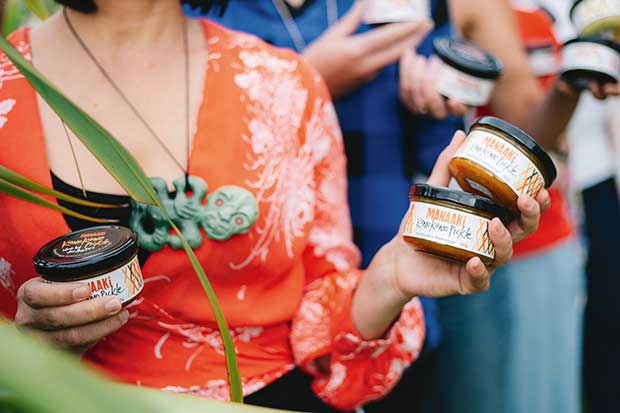
Manaaki condiments, made in Blenheim with traditional Māori ingredients, aren’t just delicious. They also spread hospitality and generosity.
Words: Lee-Anne Duncan Photos: David James.
A Manaaki prep day is a busy day at Omaka Marae. Some 10 “aunties” gather in the marae kitchen for up to eight hours; R&B is cranked up on the radio as the women chat and chop, singing along to Aretha and Beyoncé, Tupac and Prince Tui Teka.
The aunties are members of the Omaka Marae’s Māori Women’s Welfare League and are the drive behind Manaaki, the condiment range produced on the marae. “The best prep sessions are when everyone is here,” says Tineka Smith, one of the aunties. “Most of us grew up together so we share lots of memories, especially when a song comes on that sets someone off down memory lane.”
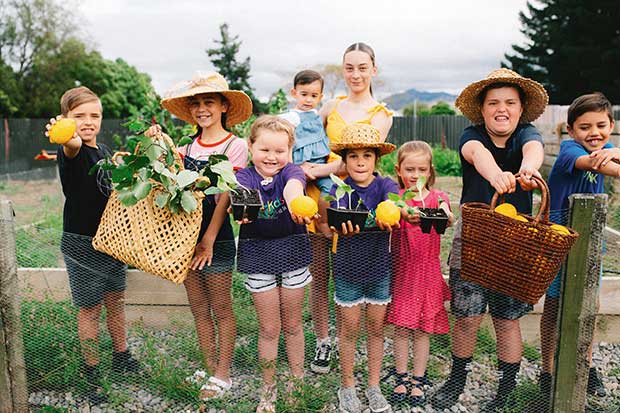
Tamariki at Omaka Marae’s after-school programme, Pā Kids.
The kitchen, the wharekai, has clearly seen years of nourishing and nurturing cook-ups. That’s essentially what the aunties are doing too, preserving “Māori culture in a jar” to nurture and nourish others. Volunteering their time, they’re chopping apples, kamokamo and kawakawa, all to be packed, weighed, labeled and stored, then made into Manaaki’s range of three (so far) products. There’s a kamokamo pickle flavoured with turmeric and mustard, and a kawakawa jelly, with the leafy kawakawa in an apple base. Then there’s a horopito and lemon sauce, like a mayonnaise or hollandaise, with the horopito’s peppery taste giving it a kick. They’re all recognizable products offering a unique flavour of Aotearoa.
But Manaaki does more than just serve up good kai. It’s part of a long-term “pā ora, pā wānanga” strategic plan to make the whole marae more self-sustaining, says Donna Nepia. Donna is another auntie who, with her husband Kiley, drives the strategic vision and organization of the marae. She also manages Manaaki day-to-day and is behind the concept and branding, which is based on the tukutuku panels in the marae’s wharenui. “We want to be self-sustaining, therefore self-determining. We wanted to develop a social enterprise, so we looked at what we were good at. And the aunties of old were great at keeping the marae pantry stocked with preserves.
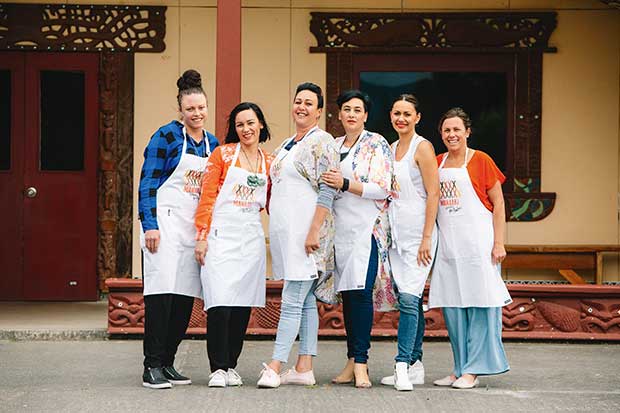
Manaaki’s condiment range is made at Omaka Marae in Blenheim. It’s most certainly a whānau creation with all the “aunties” lining up to chop and prep; (left) aunties Tineka Smith, Donna Nepia, Renata Wallace, Aroha Bond, Carleen Phillips and Sarah Wichman in front of the marae’s wharenui.
“Manaaki also fits because it safeguards the skill of preserving and encourages our people to learn about rongoā Māori, natural medicines. We grow much of the produce in our own maara kai, our marae garden, and we all help market and sell the products, so it teaches whānau new skills.” Manaaki expresses manaakitanga, meaning hospitality, kindness, generosity and support, and creating and selling the products helps the marae support its people. The aunties hope there will soon be profits from Manaaki sales to go into various programmes around the marae, including a gym, a kaupapa Māori after-school programme called Pā Kids, and a new million-dollar bilingual unit. Until then, marae groups can still fundraise through Manaaki by offering their labour — prepping for Manaaki in the kitchen, for which they’re paid.
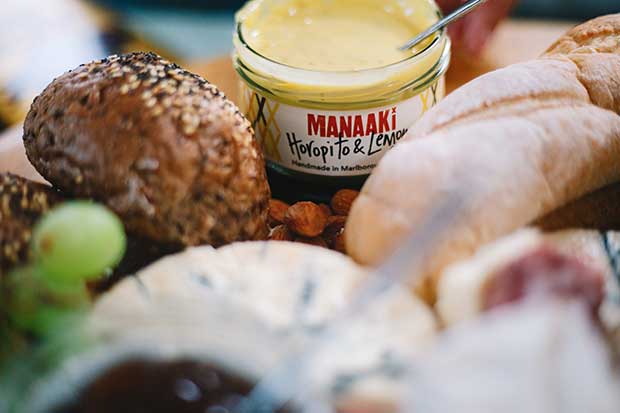
Aunties who prep are also paid a koha, which goes into their Mahana initiative, buying merino baby blankets for local whānau in need. The aunties started producing Manaaki commercially in 2016 but are quick to point out it didn’t start with them. “It’s an age-old legacy from the aunties who came before us. We’re so lucky to have some of the older aunties still with us, including Auntie Marg who gave us her kamokamo pickle recipe. Their mothers were the original aunties,” says Renata Wallace, an auntie who’s also Tineka’s sister.
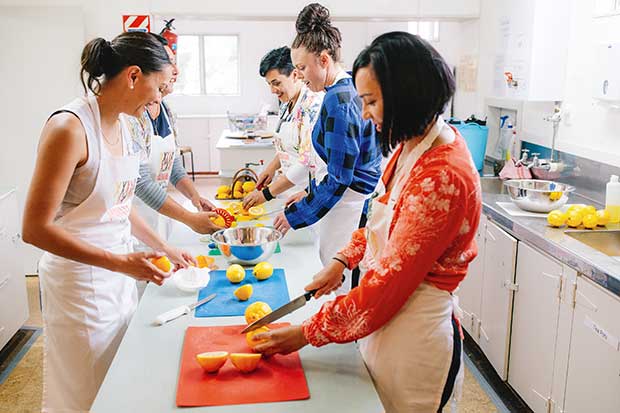
Back in 2016, Renata was the Manaaki cook. She loved it but had to fit in it after her day job, which involved helping people with disabilities live independently. “Cooking was my escape,” she says. “It was great being able to do it and put my love in there. Then seeing people eating it or saying ‘it’s so tasty’. It made me feel proud.” That job’s now passed to Renata’s friend, Wendy Rogerson, who hefts around the massive “marae pots” three times a week to cook what’s in demand. The kamokamo pickle and kawakawa jelly are done with four pots on the go — 68 jars produced per pot — while the horopito lemon sauce is carefully emulsified one pot at a time. “No one is allowed to come through the kitchen doors then. Everything has to be super hygienic,” says Renata.
That can be a challenge when tamariki are dying to help out. And they do — plenty. As part of the Pā Kids programme, which Tineka co-ordinates, they grow the kamokamo seeds from the previous year’s crop, plant the seedlings, and nurture and harvest them, trundling the grown fruit away in wheelbarrows. “We say to treat them like little pēpi — babies — and you can’t drop a pēpi,” says Tineka.
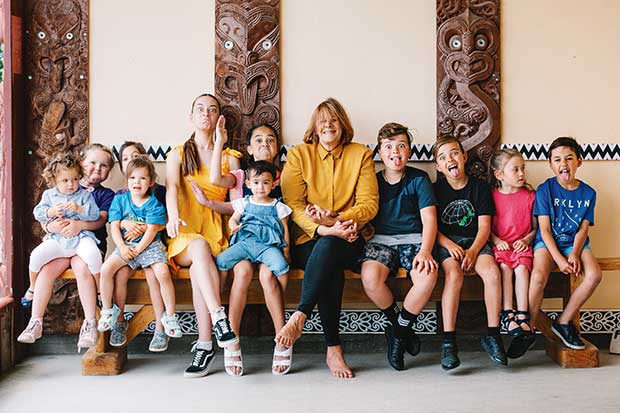
Auntie Marg Bond is very much part of the Manaaki story — her recipe is used for the kamokamo pickle. She’s joined by some of the Pā Kids outside the wharenui. Children are an essential ingredient in the Manaaki recipe — they help plant, nurture and harvest many of the fruits and vegetables used in the products.
The tamariki help with labeling and counting the number of bags of each processed product, ensuring the aunties aren’t too distracted by the singing and chatting to keep count. “As much as we can, we stick on our lovely hairnets and get the children involved. Tasting the products they’ve helped make gives them cultural identity and a sense of pride,” says Renata. The aunties, too, think back to the aunties of old who have chopped and chatted in the wharekai. “We often get quite emotional,” says Renata. “It’s exciting and a privilege to be part of all this,” says Tineka. “It’s hard work and yes, it’s voluntary, but the rewards and the benefits to the wider community and to us are incredible.”
And that’s what Manaaki is all about. It’s about creating a strong tomorrow for the marae, about aroha and Māori culture. And it’s about whakawhanaungatanga — the sense of connection to community. That’s a potent pot, even before you crack the lid.
WHAT’S IN MANAAKI?
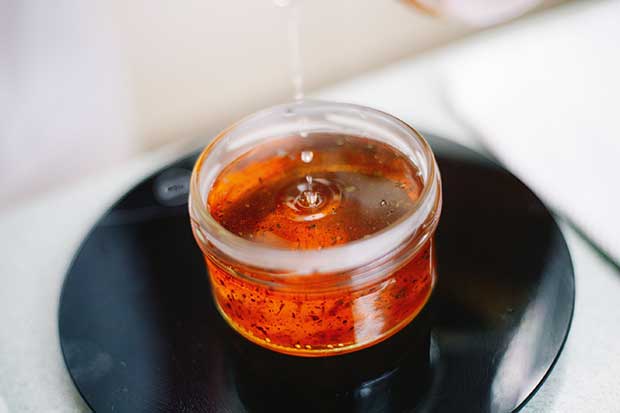
Kamokamo: A greenish-yellow squash or marrow-like vegetable, which was a traditional Māori staple. Sometimes known as kumi kumi, it can be cooked many ways.
Horopito: A peppery green and rust-coloured leaf containing polygodial. Māori have long used it for medicinal purposes, including treating fungal skin infections, stomach aches and diarrhoea, and as a painkiller.
Kawakawa: A versatile and important healing herb, kawakawa is used to treat cuts and bruises, toothache, stomach and rheumatic pain, as well as being an anti-inflammatory and antimicrobial.
GOOD TASTE
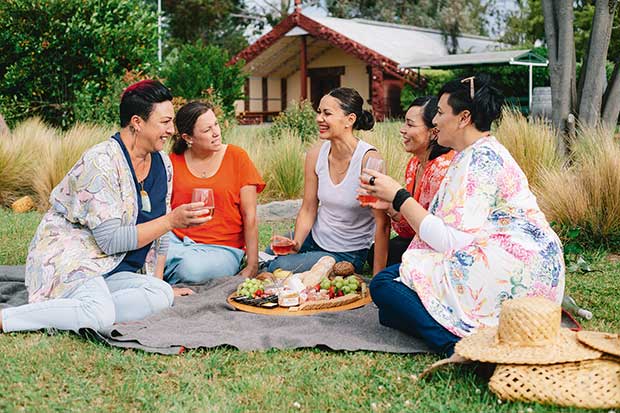
● For afternoon tea, spread scones with Manaaki Kawakawa Jelly and a dollop of freshly whipped cream.
● For an antipasto platter, team Manaaki Kamokamo Pickle with cured meats, kawakawa jelly with a favourite cheese or two, and Manaaki Horopito & Lemon Sauce with kaimoana.
● Layer finely sliced rare roast beef, smoked cheddar and the kamokamo pickle on warm toasted ciabatta with peppery rocket.
● Take a favourite cracker and add kawakawa jelly with blue cheese, semi-dried figs and candied walnuts.
● For a meal, serve oven-roasted brown-sugar and sea-salt salmon fillet with watercress, sticky balsamic glaze and the horopito and lemon sauce.
● Serve slow-cooked rare roast beef with watercress and horseradish, finished with horopito and lemon sauce.
● Slow-cook a shoulder of pork in a braise of kawakawa jelly, hoisin sauce, balsamic vinegar, chopped garlic and sliced onion until the meat is falling apart. Serve in slider buns with Asian coleslaw.
Love this story? Subscribe now!
 This article first appeared in NZ Life & Leisure Magazine.
This article first appeared in NZ Life & Leisure Magazine.
